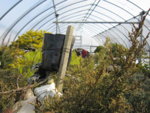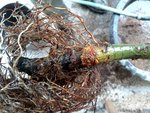Johnnyd
Shohin
I did not seal the stub on the bottom.When I harvest air layers, I cut the stem well below the girdle, and I do not trim this 'stub' until the first repotting. I don't use any sealants.
IOW, the two layers I have now still have this 2 to 4 inch long 'stub' below the girdle. I simply remove the plastic that was covering the sphagnum and pot the works in a standard garden center plastic pot that I fill with Turface MVP. Usually this is 5 gallon size pot. I screw two diametrically opposed bamboo sticks to the pot and tie the upper parts of the layer to them so the roots won't be moved (analogous to what landscapers do when planting trees).
My one successful layer was the largest I had made until the two I currently have that were harvested Aug/Sep 2018. It was about 3 feet tall with a one inch-ish caliper. This year's layers are close to 4 feet and about 1.25 inch calipers.
My normal habit is to be repotting the layers about now, and trimming off the stub up to the bare wood in the girdle. I did not this with some of last year's layers, yet they crapped out too. I am not repotting and trimming this year's layers (meaning the two layers I potted last Aug/Sep versus last year's = harvested Aug/Sep 2017).
@River's Edge raised this possibility earlier so I did spend some time in the winter picking sphagnum away from the (adventitious) root collar - more so on one than the other. Correspondingly, I kept the MVP level lower with the 'picked' one.
Again, the wad of sphagnum is about fist size and it is set in the upper half of the depth of a 5 gallon plastic nursery pot filled with MVP. Roots grew out radially since last Aug/Sep to the extent that the pot of Turface is fully populated, on the surface anyway. For me, the problem hasn't appeared until after the first leaves are out - we're not quite to that time.
What are the details of what you do / you done, @Johnnyd?
I did remove as much of the old sphagnum moss as possible. It was placed in boons mix with some fresh sphagnum on top. When is got warm in January/ February I did a root drench with the H2O2 solution you recommend. When buds swelled I alternated between daconel and Lyme sulfur every 2 weeks. Also been fertilizing plus "Root Ruckus ". I did not repot it this spring because I thought it was common practice to leave it alone until the following spring.













